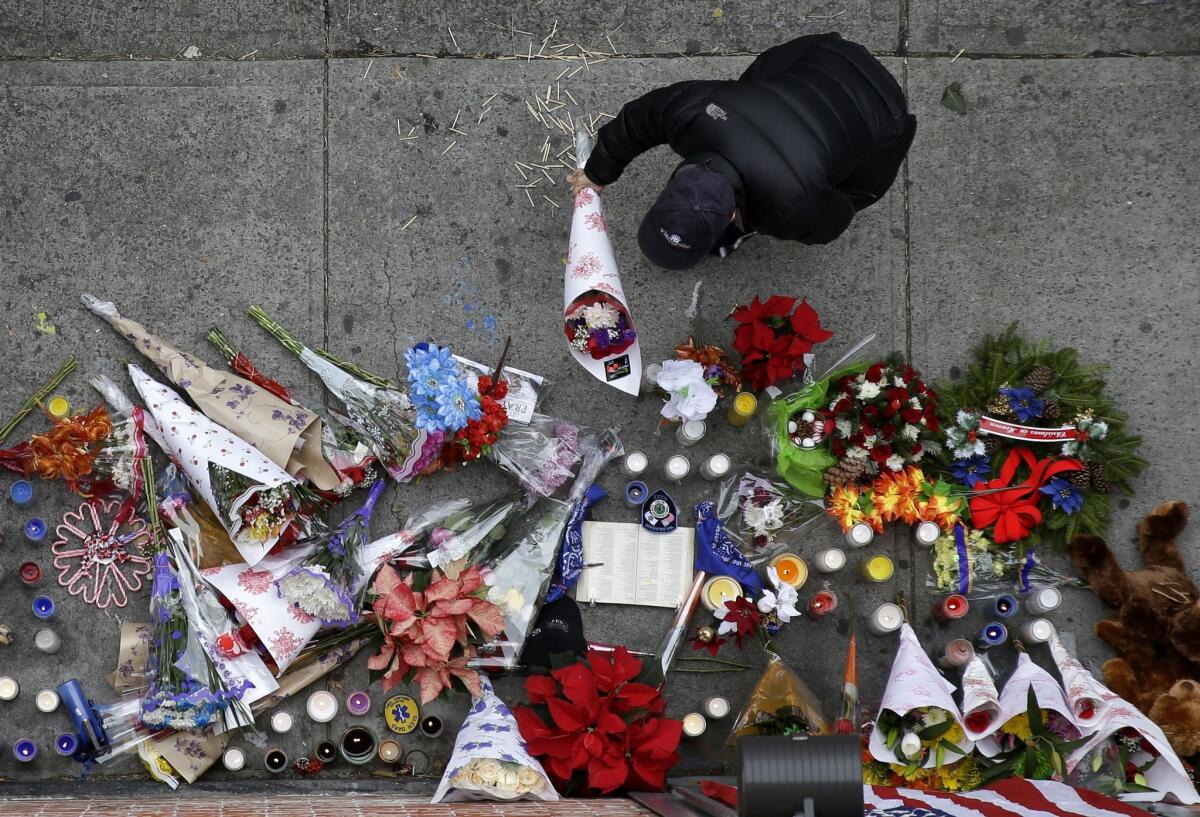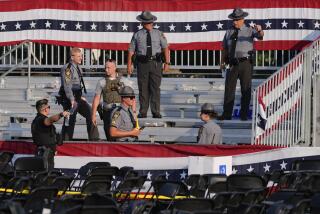N.Y. police say gunman who killed officers told bystanders to watch him

- Share via
Reporting from New York — Minutes before he gunned down two police officers, a man told two bystanders, “Watch what I’m going to do,” officials said Sunday as they pieced together the movements of a killer whose actions further roiled relations between the mayor and police unions and cast a shadow on a civilian-led protest movement alleging police brutality.
Politicians, clergymen and activists urged an end to the politicization of Saturday’s killings of New York Police Department Officers Wenjian Liu and Rafael Ramos. Some political leaders said demonstrators who are critical of police should halt their almost nightly marches until Liu and Ramos are buried.
“I’m asking all of those to hold off on any form of protest until these officers are laid to rest in a peaceful manner,” the Brooklyn borough president, Eric Adams, said as he stood in front of a growing memorial to Liu and Ramos.
Bouquets of flowers, candles, a Christmas wreath and a menorah began covering the sidewalk near the busy intersection where Ismaaiyl Brinsley, 28, ambushed the officers as they sat in their patrol car. As night fell, scores of people gathered at the spot for a candlelight vigil in the officers’ memory.
At the same time, marchers in Harlem held a separate “vigil for justice” organized by a group that has held demonstrations alleging police brutality.
This time, there were no anti-police chants or signs among the roughly 50 marchers. Many of them participated in past protests that followed the death in July of Eric Garner, an unarmed black man who died during an altercation with police, helping set off the ongoing demonstrations.
“I’m here because all life is valuable and all life matters,” said Elle Green, a social worker. “Just because you’re angry doesn’t mean you’re anti-law enforcement,” she said, referring to rage over Garner’s death.
“We want to see changes, but at the same time, we want the police to know that we support them,” said Stephen Phelps, a clergyman who also has taken part in protests accusing police of abuse of power.
It was unclear how, or whether, the boisterous marches of the last five months would continue given the fallout from Saturday’s killings. Leaders of the city’s police unions, who have accused Mayor Bill de Blasio of siding with protesters, say his leniency toward them laid the groundwork for Brinsley’s rampage.
“There’s blood on many hands tonight,” the president of the Patrolmen’s Benevolent Assn., Patrick Lynch, said Saturday night. “That blood on the hands starts at City Hall in the office of the mayor.”
Even some of those urging an end to the political jabs Sunday expressed anger at De Blasio, who has defended protesters’ rights to demonstrate and who on Friday further angered critics by meeting with some protest organizers.
“What if that was your son sitting in that police car, if that was your son that got shot in the head?” said Juan Rodriguez, a Brooklyn civic leader and friend of Ramos who took part in a news conference outside the slain officer’s home. De Blasio “needs to show a little more support for the officers in blue.”
Many police officers turned their backs on De Blasio when he arrived at the hospital where Liu and Ramos were taken after they were shot. The mayor, who took office in January with promises to improve community-police relations, has rejected accusations that he is biased against the police and has repeatedly defended Police Commissioner William J. Bratton and the 35,000-strong force as the best in the world.
Lynch last week called on police officers to sign statements demanding that De Blasio not attend funerals of officers killed on duty. It was unclear when funerals for Liu and Ramos would be held or whether De Blasio would follow mayoral tradition and attend them.
Liu was 32 and had been married for two months. Ramos was 40 and had a 13-year-old son, Jaden, who posted an online tribute to his father, calling him “the best father I could ask for.”
“It’s horrible that someone gets shot dead just for being a police officer. Everyone says they hate cops but they are the people that they call for help,” Jaden wrote.
Outside the house where Ramos grew up, his aunt delivered a brief statement. “I hope and pray that we can reflect on this tragic loss of lives that have occurred so that we can move forward and find an amicable path to a peaceful coexistence,” Lucy Ramos said.
Police gave a detailed account of Brinsley’s last hours and of his troubled background. According to law enforcement officials in Maryland and New York, Brinsley’s rampage began about 5:30 a.m. Saturday when he used a key that he was not supposed to have to enter the apartment of his former girlfriend in Owings Mills, Md.
The two argued and Brinsley shot her in the stomach, NYPD Chief of Detectives Robert Boyce said. It was about 5:50 a.m.
“At about 6:05 he calls the girlfriend’s mother and says he shot her by accident and hopes she lives,” Boyce said. The woman was expected to survive.
Police think Brinsley, 28, then caught a bus to New York City and took his ex-girlfriend’s cellphone. Officials used pings from the phone to trace his movements, some of which were captured on video. Brinsley was seen near a major bus drop-off point in Manhattan, getting ready to board a subway. A couple hours later, he was again captured on video, talking to two men in the Bedford-Stuyvesant neighborhood of Brooklyn.
The men have been contacted by police and are not suspected of involvement in the shooting, Boyce said.
“He asks for their gang affiliation,” Boyce said. “He asks them to follow him on Instagram. He then says, ‘Watch what I’m going to do.’”
Minutes later, Brinsley approached the officers’ car from behind and opened fire through the passenger-side window. Police responding to calls of shots fired pursued Brinsley, who ran into a nearby subway station and shot himself to death.
Brinsley had posted on Instagram earlier: “I’m putting wings on pigs today. They take 1 of ours, let’s take 2 of theirs.” He hashtagged the names of Garner and Michael Brown, an unarmed black man killed by police in Ferguson, Mo., in August.
Jimmy Hicks has lived in the neighborhood for decades and is accustomed to seeing officers on patrol. “I said to myself, ‘Oh, my gosh,’” when he heard what happened, Hicks said. He credited police with helping bring down crime in the area and dismissed critics who accused them of being overly aggressive.
Hicks, who is black, said he felt sorry for the families of Garner and other unarmed men who have died in encounters with police. “But the cops have a job to do,” he said. “They’re not racist.”
Boyce said Brinsley, a black man who was born into a Muslim family, showed no signs of radicalization, despite anti-police rants he posted on social media in the hours before the killings. He was estranged from his family, and his mother described him as having a troubled childhood and a history of suicide attempts, Boyce said. Even Brinsley’s mother feared him, he said.
Brinsley had at least 19 arrests — 15 in Georgia and four in Ohio, Boyce said. His convictions included felony shoplifting, grand larceny, destroying property and possession of a stolen gun.
On the morning of the shootings, he posted a portentous message on Facebook. “I Always Wanted To Be Known For Doing Something Right,” Brinsley wrote. “But My Past Is Stalking Me And My Present Is Haunting Me.”
Times staff writer Matt Pearce in Los Angeles and special correspondent Maya Srikrishnan in New York contributed to this report.
More to Read
Sign up for Essential California
The most important California stories and recommendations in your inbox every morning.
You may occasionally receive promotional content from the Los Angeles Times.











